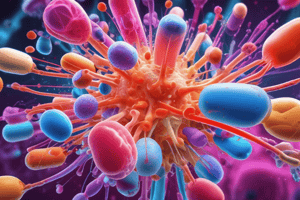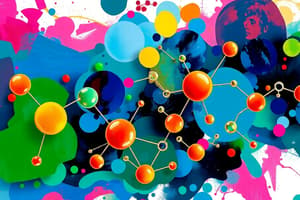Podcast
Questions and Answers
What is a mechanism associated with microbial resistance to antibiotics?
What is a mechanism associated with microbial resistance to antibiotics?
- Increase in microbial membrane permeability to antibiotics
- Development of new antibiotics
- Production of antibiotic inactivating enzymes (correct)
- Use of adjunctive agents to protect against antibiotic inactivation
What is a key strategy to combat microbial resistance?
What is a key strategy to combat microbial resistance?
- Increased use of single antibiotic regimens
- Use of antibiotic combinations
- Decreased development of new antibiotics
- Avoidance of misuse of antibiotics (correct)
What is the main factor to consider when selecting an antimicrobial agent?
What is the main factor to consider when selecting an antimicrobial agent?
- Safety/Toxicity
- Efficacy/Spectrum (correct)
- Convenience/Compliance
- Cost
What characteristic should the ideal antimicrobial agent have?
What characteristic should the ideal antimicrobial agent have?
What is the main reason for not using antibacterial agents to treat viral diseases?
What is the main reason for not using antibacterial agents to treat viral diseases?
What is the main concern related to the use of antibiotics for non-bacterial conditions?
What is the main concern related to the use of antibiotics for non-bacterial conditions?
What is the main reason for not finishing the treatment duration of antibiotics?
What is the main reason for not finishing the treatment duration of antibiotics?
Flashcards are hidden until you start studying
Study Notes
Key Concepts in Antimicrobial Therapy
- Antibiotics: Substances that kill or inhibit the growth of microorganisms.
- Selective Toxicity: Targeting microorganisms without harming human cells, exploiting differences in metabolism and structure.
- Therapeutic Index: Ratio indicating the safety of a drug; the higher the index, the safer the drug.
- Bacteriostatic vs. Bactericidal: Bactericidal drugs kill bacteria, whereas bacteriostatic drugs inhibit growth.
Mechanisms of Action
- Antibiotics can:
- Inhibit cell wall synthesis (common in betalactams).
- Interfere with cell membrane function.
- Disrupt ribosomal function (protein synthesis), either reversibly (bacteriostatic) or irreversibly (bactericidal).
- Inhibit nucleic acid metabolism and block enzymatic activities (antimetabolites).
Microbial Classification
- Important microorganisms include:
- Bacteria: e.g., Staphylococcus aureus.
- Viruses: e.g., HIV.
- Fungi: e.g., Candida albicans.
- Parasites: e.g., Plasmodium falciparum.
Types of Antimicrobial Therapy
- Prophylaxis: Prevents infection in high-risk patients (e.g., immunosuppressed individuals).
- Pre-emptive Therapy: For asymptomatic patients showing laboratory signs of infection; delivered prior to symptom development.
- Empiric Therapy: Started before specific organisms are identified, based on common pathogens.
- Definitive Therapy: Narrowed down once pathogen identification and susceptibility are available.
- Suppressive Therapy: Continued at lower doses to manage chronic infections without complete eradication.
Pharmacokinetic Principles
- Minimum Inhibitory Concentration (MIC): Lowest concentration of an antibiotic that prevents visible growth of bacteria.
- Minimum Bactericidal Concentration (MBC): Concentration required to kill the bacteria.
- Inoculum Effect: Increased bacterial density requires higher levels of antibiotics to achieve efficacy.
Bactericidal vs. Bacteriostatic Activities
- Bactericidal Drugs: Useful in life-threatening infections; effective when host defenses are impaired.
- Bacteriostatic Drugs: Require active host immune responses for efficacy and do not kill bacteria directly.
- Post-Antibiotic Effect (PAE): Continued suppression of bacterial growth after removal of antibiotic.
Dosing Considerations
- Continuous dosing maintains stable drug levels, while bolus dosing produces high peaks but may risk toxicity.
- Time-Dependent Killing: Drug effects depend on maintaining concentrations above MIC for extended periods (e.g., beta-lactams).
- Concentration-Dependent Killing: Increased effectiveness with higher peak concentrations (e.g., aminoglycosides).
Phases of Bacterial Growth
- Lag Phase: Initial metabolic activity without cell division.
- Log Phase: Rapid division; effective for beta-lactam drugs.
- Stationary Phase: Cell division slows; balance of new cells and deaths.
- Death Phase: Declining viable bacteria count.
Antimicrobial Drug Combinations
- Most infections should ideally be treated with single agents; combination therapy may lead to synergism or antagonism.
- Synergism: Combined effects are greater than individual effects; important in specific pathogen cases.
- Antagonism: Combined effects are less effective; notable with bacteriostatic agents inhibiting the efficacy of bactericidal antibiotics.
Clinical Decision-Making
- Selecting appropriate antibiotics involves understanding if a drug is cidal or static and using guidelines for effective treatment.
Studying That Suits You
Use AI to generate personalized quizzes and flashcards to suit your learning preferences.




